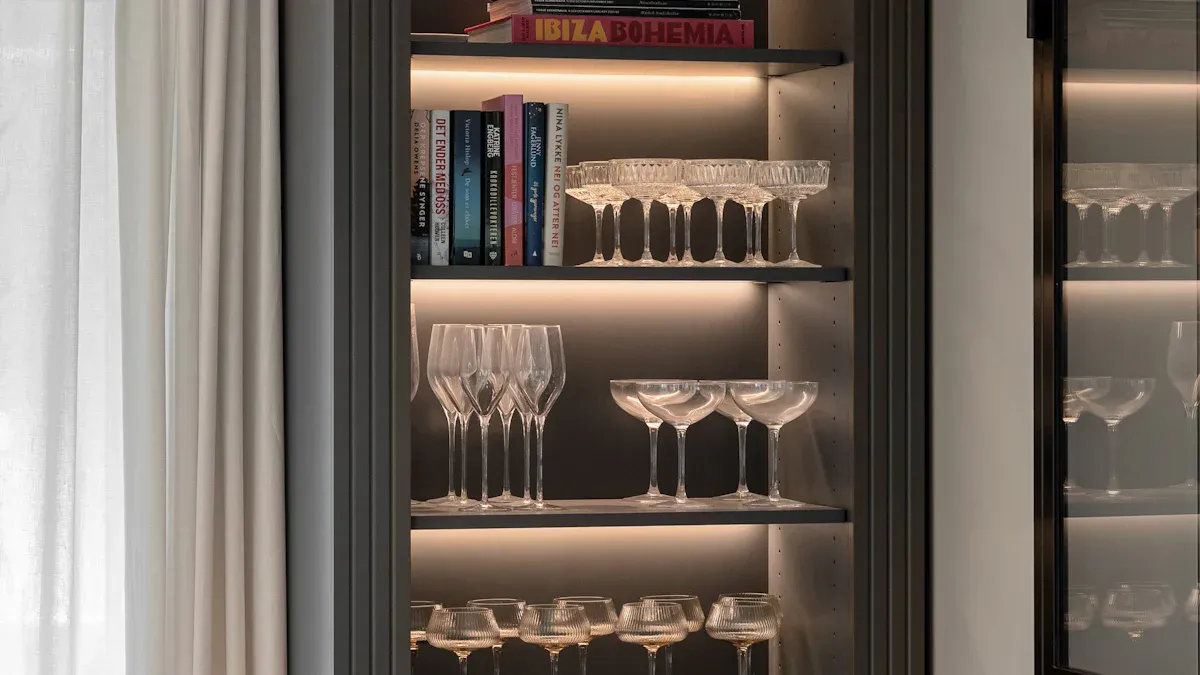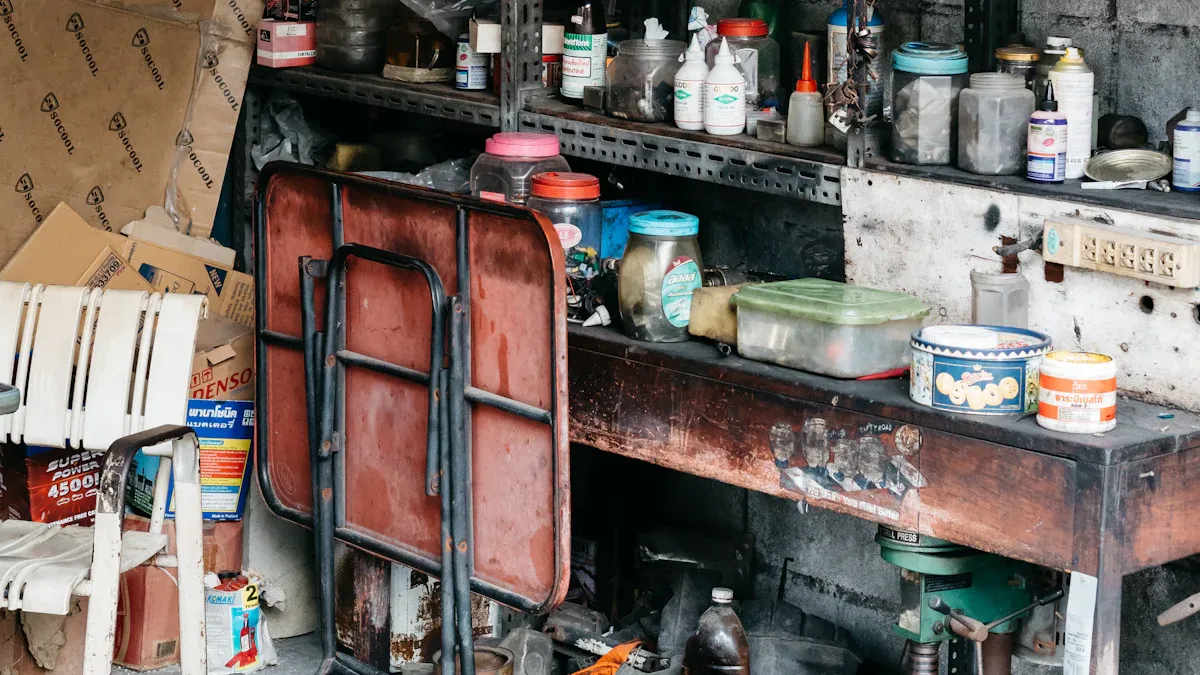Your 2025 Guide to Storage Directions
Table of Contents

You should view storage directions as non-negotiable rules. They are essential instructions that protect your health and your investment. Following proper storage ensures a product works effectively from its first use to the last. Improper storage can have serious consequences. For instance, poor food storage contributes to a significant number of foodborne illnesses each year. Medications also lose potency when exposed to the wrong temperature or humidity. This degradation can make them less effective or even harmful.
Note: Ineffective chill storage and refrigerator management alone may cause up to 50% of foodborne illness cases in homes.
COMMON STORAGE DIRECTIONS
You see these storage directions on countless products. Understanding them is key to keeping items safe and effective. Let’s decode what these common labels really mean for you.
‘COOL, DRY PLACE’ MEANING
This instruction is more specific than you might think. A “cool place” refers to a consistent temperature, ideally between 46°F and 59°F (8°C and 15°C). A “dry place” means the relative humidity should stay below 60%. These conditions prevent unwanted changes in your products.
Tip: Your bathroom cabinet is often warm and humid, making it a poor choice for storage. A pantry or a bedroom closet is usually a better option.
High humidity is especially damaging to dry goods. When humidity levels exceed 60%, spices like cinnamon absorb moisture and form hard, irreversible clumps. This moisture also accelerates the degradation of spices by as much as 300%. Proper storage in the right conditions is crucial.
‘REFRIGERATE AFTER OPENING’
When you open a sealed product, you expose it to oxygen and microorganisms. Refrigeration slows down spoilage and preserves quality. Consider ketchup: its natural acidity prevents it from spoiling at room temperature, but Heinz recommends refrigeration to maintain its flavor and freshness. The same goes for mayonnaise. You can keep opened mayonnaise at room temperature for about a month, but refrigeration extends its life to two months.
Other common condiments also benefit from a cold temperature:
- Mustard
- Barbecue sauce
- Soy sauce
- Salsa
Refrigerating these items helps maintain their intended color, texture, and taste for a longer period.
‘KEEP FROM SUNLIGHT’
Sunlight, specifically UV radiation, can degrade products. This is a major issue for skincare containing active ingredients like Vitamin C and retinol. Exposure to light can render these ingredients ineffective. Studies show that light causes more damage to retinoids than temperature does. That is why many sensitive products come in dark or opaque packaging, like amber glass, which blocks damaging UV rays.
This rule also applies to medications. Certain drugs, including common antibiotics and anti-inflammatories like ibuprofen, can become less effective or even cause your skin to become more sensitive to the sun after exposure. Always check your medicine’s storage information.
GUIDE TO WINE STORAGE

Proper wine storage is crucial for preserving the flavor and value of your collection. You can protect your fine wines by creating the right environment. Understanding how to store wine properly ensures every bottle is ready to be enjoyed. Your goal is to replicate the conditions of a traditional wine cellar. This means finding a space that is dark, cool, and free from vibrations.
HOW TO STORE WINE PROPERLY
You should find a cool, dark, and relatively undisturbed area for your wine. The ideal humidity is between 60-70%. This level of humidity keeps corks from drying out without encouraging mold. For serious collectors, a dedicated wine fridge or wine cooler offers precise temperature and humidity control. If you have the space, you can even build a wine cellar for optimal long-term storage.
Pro Tip: Avoid storing wine near appliances like washing machines or on top of your regular refrigerator. The constant vibrations can disturb the sediment in the wine and speed up chemical reactions, negatively affecting the aging process.
WHY WINE IS STORED SIDEWAYS
You should store your wine with natural corks horizontally. A bottle of wine is stored on its side to keep the cork moist. A moist cork maintains a tight seal, preventing oxygen from seeping in and spoiling the wine. A dry cork can shrink and crack, which allows air to enter and cause oxidation. This horizontal method also makes for efficient wine storage. However, this rule does not apply to wine with screw caps or synthetic corks; you can store those upright. For bottles with natural corks, keeping the wine stored on its side is essential for long-term storage.
IDEAL STORAGE TEMPERATURE FOR WINE
The ideal storage temperature for wine is between 45-65°F (7-18°C), with 55°F (13°C) being optimal. More important than the exact number is temperature consistency. Rapid temperature swings can damage a wine. Storing wine at the wrong temperature mutes its flavor. A red wine served too warm can taste overly alcoholic, while a white wine served too cold loses its complex aromas. A wine fridge is excellent for maintaining this stable temperature. For long-term storage, these steady conditions are non-negotiable to allow your fine wines to mature gracefully.
RISKS OF IMPROPER STORAGE

You now understand the rules, but what happens if you ignore them? Failing to follow storage directions can lead to serious problems. These issues range from wasted money to significant health risks. Proper storage is not just a suggestion; it is a critical step for safety.
BACTERIAL GROWTH
When you store food improperly, you invite harmful bacteria to grow. The USDA defines the “Temperature Danger Zone” as the range between 40°F and 140°F. In this temperature range, bacteria can double in number in as little as 20 minutes. This is why you must keep perishable foods refrigerated. The same risk applies to medical products. In hospital settings, improper storage has led to serious issues:
- Enterobacter cloacae infections in children were traced back to a contaminated pharmacy.
- Pseudomonas putida septicemia in a nursery was caused by contaminated flush solutions.
These cases show how dangerous poor storage conditions can be.
LOSS OF POTENCY
Heat, light, and air can make products less effective. This process is called degradation. Two common chemical reactions, oxidation and hydrolysis, break down active ingredients. This is a major concern for vitamins and medications.
Vitamin C, for example, degrades when exposed to light and heat. This is why manufacturers often add extra Vitamin C to products to ensure they meet the label’s claim by the expiration date.
Sunscreen also loses its power in a hot car, leaving you unprotected from UV rays. Even insulin can be destroyed by extreme temperature changes, making it unusable. You might not know your wine has gone bad until you taste it, but with medicine, the consequences of lost potency are far more severe. The same goes for wine; if the temperature is too high, the wine will age too quickly, and you will know the wine has gone bad from its flat, cooked taste. The ideal storage for wine is a consistent, cool temperature.
PRODUCT SEPARATION
Have you ever seen a lotion or salad dressing look curdled or watery? This is product separation. It happens when temperature extremes break down an emulsion, which is a mix of oil and water. Freezing or overheating can cause the ingredients to separate. When a medicated cream separates, the active ingredient is no longer evenly distributed. You might get too little of the medicine in one dose and too much in another. This makes the product unreliable and potentially unsafe. This is why following the recommended storage conditions is so important for both safety and effectiveness. Just as with wine, where the wrong temperature can ruin the experience, improper storage can ruin a product. The best wine is a well-kept wine. A great wine deserves great care. That wine you saved will thank you.
You now see that following storage directions is a simple action with big rewards. It protects your health, ensures products work, and saves you money. You can create a quick-reference guide for your home to make it even easier.
Your Home Cheat Sheet 📝
- Cool, Dry Place: Pantry or cabinet, not the bathroom.
- Refrigerate After Opening: Fridge interior, not the door.
- Wine Storage: Sideways in a cool, dark spot. This protects your wine, wine, wine, wine, wine, wine, wine, wine, and wine.
You have the power to protect your products. Following storage directions gives you control over the safety and longevity of everything you own, including that special bottle of wine.
FAQ
Why is the bathroom a bad storage spot?
You should avoid storing items in your bathroom. Showers and baths create high heat and humidity. These conditions can damage medications, vitamins, and skincare products. This environment also encourages mold and bacteria to grow, making your products unsafe.
What’s wrong with storing items in the fridge door?
You expose items in the refrigerator door to frequent temperature changes. Every time you open the door, the temperature rises. This instability can spoil sensitive foods like milk and eggs faster. You should keep them on the main shelves for consistent cold.
Do storage directions matter if the product isn’t expired?
Yes, storage directions are always important. An expiration date is only accurate when you store the product correctly. Improper storage can cause a product to lose its effectiveness or spoil long before its printed expiration date.
Can I freeze products to make them last longer? 🥶
You should check the label before freezing any product. Freezing can damage many items, especially emulsions like lotions or mayonnaise. The extreme cold can cause ingredients to separate, ruining the product’s texture and effectiveness.
Remember: Always follow the label’s instructions for the best results.

Poseidon
Master of Nutritional Epidemiology, University of Copenhagen, Herbal Functional Nutrition Researcher
Focus: The scientific application of natural active ingredients such as Tongo Ali, Horny Goat Weed, and Maca to sexual health and metabolic regulation.
Core Focus:
Men: Use a combination of Tongo Ali (an energizing factor) + Maca (an energy reserve) to improve low energy and fluctuating libido.
Women: Use a combination of Horny Goat Weed (a gentle regulator) + Maca (a nutritional synergist) to alleviate low libido and hormonal imbalances.
Stressed/Middle-Aged Adults: This triple-ingredient synergy supports metabolism, physical strength, and intimacy.
Product Concept:
Based on traditional applications and modern research (e.g., Tongo Ali promotes testosterone-enhancing enzyme activity, and icariin provides gentle regulation), we preserve core active ingredients and eschew conceptual packaging—using natural ingredients to address specific needs.
Simply put: I'm a nutritionist who understands "herbal actives." I use scientifically proven ingredients like Tongo Ali, Epimedium, and Maca to help you make "sexual health" and "nutritional support" a daily routine.
